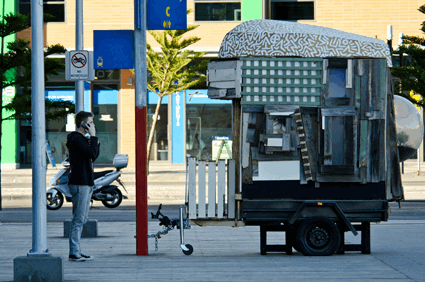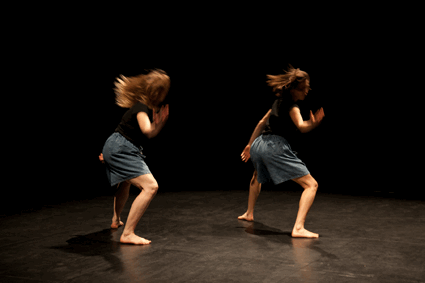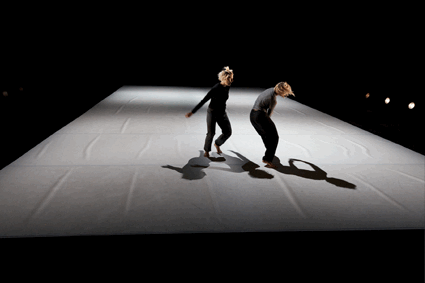next wave day tripping
jane howard: 2012 next wave's day passes

Shelters, Joseph L Griffiths, Next Wave Festival 2012
photos Sam Ackroyd
Shelters, Joseph L Griffiths, Next Wave Festival 2012
NEXT WAVE’S DAY PASSES INVITE AUDIENCE MEMBERS TO SHARE A CURATED JOURNEY THROUGH THE 2012 PROGRAM, A NEW WAY TO EXPLORE THE FESTIVAL. THROUGHOUT THE DAY, PARTICIPANTS ARE INVITED TO STICK WITH THE RING LEADERS AS MUCH OR AS LITTLE AS THEY LIKE.
The structure was not without problems: in particular when separated there was no way to get back in contact, only the hope you would find your way to the next location and re-find your group there.
Starting with Breakfast Club, participants are engaged through table-based conversations in response to talks by invited speakers. Turning the conversations back into small collectives created a democratic space where everyone in the room was given a voice.
Day Pass Two then moved on to visual art. Taking inspiration from Melbourne’s Docklands, Joseph L Griffiths’ Shelters sits against the chrome of the new suburb while Laura Delaney and Danae Valenza’s Hull embraces the 150-year history of Mission for Seafarers.
Griffiths’ installation of a series of three sculptures built from found materials from the Docklands juxtaposes seemingly liveable wooden structures of handcrafted, small-scale beauty against the harsh high-rises of the Docklands.
Walking through the mission chapel we find that Hull shares the space with old stained glass windows and music from the rehearsal of a young group of international students. Hull comprises installation sculptures, ice spheres suspended from the domed roof of the gymnasium and a storeroom seemingly taken over by salt. These sit alongside found archival material of photographs, maps and film distributed throughout the mission. However the routine activities of the mission and the melding of old and new outshines the work brought to the space. While the surrounds illuminate Griffiths’ work, in some ways Hull is obscured by them.

PHYSICAL FRACTALS, Natalie Abbott, Next Wave Festival 2012
photo Pia Johnson
PHYSICAL FRACTALS, Natalie Abbott, Next Wave Festival 2012
Day Pass Two also focused on dance. Natalie Abbott’s evocative PHYSICAL FRACTALS places the audience in a circle surrounding the performance space. From total blackout, the work begins as Abbott and Rebecca Jensen are revealed to be standing startlingly close to the audience. The performance builds in a series of repetitions, torsos bent over and arms circling as feet scoot back across the floor, before the dancers return to stand on the rim of the circle. Patterns repeat, so when one of the dancers moves in a slightly different direction it is startling. Just as this pattern seems unbreakable and about to outstay its welcome the dancers move into another pattern across the wooden floor.
Daniel Arnott’s live soundscape is built from the sounds of the room. At first we hear just the unamplified sounds of Abbott and Jensen’s movement. Then microphones, trained onto the wooden floor, allow sound to cycle and build with the performance.
As Govin Reuben’s lighting again plunges us into darkness, the room is filled with the noise of the performers swinging microphones above their heads. When lit, the taut cords are revealed to appear dangerously close to the audience. When the microphones are dropped the pair run around the room, lights oscillating in time with their circling.
If at 50 minutes the work occasionally appears to be too repetitive, it is not until it ends that the full sensory impact of the work is felt, and you are left reeling.

Wintering, Aimee Smith, Next Wave Festival 2012
photo Pia Johnson
Wintering, Aimee Smith, Next Wave Festival 2012
Choreographer Aimee Smith, currently studying her Masters Degree in Sustainability, developed Wintering after travelling to the Arctic Circle. In a deep performance space, Smith’s choreography carries with it representations of water mutating from a slowly fracturing ice state into a dynamic water flow.
Smith’s choreography through these changing states takes on an assured beauty in the bodies of dancers Rhiannon Newton and Jenni Large—Newton in particular with a performance built from controlled tension, her joints cracking over each other.
Trent Suidgeest’s lighting sees solitary shafts of light in the dark rising in intensity and reach, while Ben Taaffe’s sound design also grows as it moves from the deep crackling of ice through to full electronica encompassing the space.
It seems unfavorable to Smith’s theme that the work is at its most dynamic with the speed and vitality the dancers exhibit during the ‘warmest’ state. While Newton and Large present this work with facial expressions suggesting stress, Smith fails to engender in her audience a sense of urgency about climate change, much less a call to arms.
While travelling from venue to venue, works were discussed in detail with fellow Day Passers. Seeing works together you had a greater sense of the festival as a whole, although comparisons were an unfortunate side effect for some works on the curated journey. But the group experience, from morning to night, made you feel less like you were observing Next Wave and more like you were a part of it.
Next Wave Festival 2012: Shelters, Joseph L. Griffiths, Docklands, May 19-27; Hull, Laura Delaney and Danae Valenza, Mission to Seafarers, May 19-27; PHYSICAL FRACTALS, creator, dancer Natalie Abbott, dancer Rebecca Jensen, sound design Daniel Arnott, lighting Govin Reuben (Rubix Cube), dramaturg Matthew Day, Footscray Community Arts Centre, May 19-26; Wintering, choreography, direction Aimee Smith, dancers Rhiannon Newton, Jenni Large, lighting Trent Suidgeest, sound design Ben Taaffe, Arts House Meat Market May, Melbourne, 19-27
RealTime issue #109 June-July 2012 pg. web






